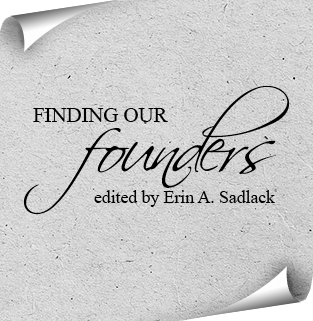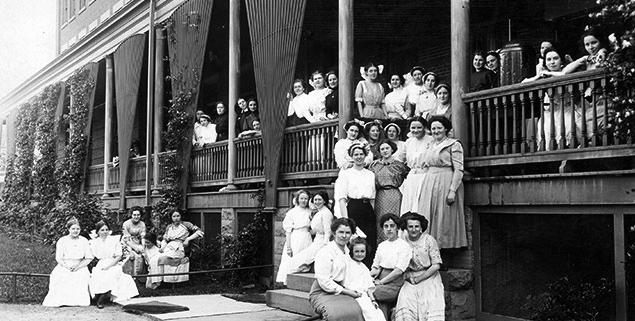 As Marywood celebrates its centennial in 2015, the voices and vision of our founding mothers—the IHM Sisters and the first graduating class of 1919—resonate with especial clarity. This project seeks to free these voices from the archive so that the Marywood community of today may understand better the nature of our history as we seek to shape the century to come.
As Marywood celebrates its centennial in 2015, the voices and vision of our founding mothers—the IHM Sisters and the first graduating class of 1919—resonate with especial clarity. This project seeks to free these voices from the archive so that the Marywood community of today may understand better the nature of our history as we seek to shape the century to come.
"We’ll sing of our stately college,
With its classic doors thrown wide,
And the rank and file of students,
A great city’s hope and pride."
Brimming with pride and confidence, Mother M. Germaine O'Neill’s poem "We'll Sing Congratulation" expresses her dream for Marywood, a place where “our halls of learning” are “renowned throughout the state” for the lessons, both intellectual and moral, taught here.
“The morality of women is the salvation of the world. But the piety of women must be educated to intellectuality before it can be the effective instrumentality of this moral elevation.”
In a 1913 fundraising letter to the Knights of Columbus, Mother Germaine writes passionately about the need for women’s higher education and the power of women as a force for good in society.
“O ye Bay Leaves and Marywood girls that are to follow in our footsteps! It has been a big thing to attempt—but so far we have not been afraid of big things in our college. Why?”
Here we heed the students' contribution as they write proudly of their first issue of the literary magazine, The Bayleaf. Sensitive to their responsibility to create a strong foundation for generations of students to come, these women demonstrate that leadership has been a hallmark of Marywood’s mission from its inception as they sought to make their mark inside the classroom and out.
This project seeks to make accessible their voices by publishing an extraordinary array of documents that illuminate details of Marywood’s history. In particular, the letters of the founding Mother—General M. Germaine O’Neill—testify to her efforts in fundraising and founding the school that would become Marywood College. For instance, a letter to a disgruntled colleague who apparently also had a school called Marywood explains how the Mother-General first devised the name; she then outlines in explicit detail and irrefutable logic all the reasons why that name would remain in place despite her colleague’s request for a change. Another letter she received praises her work at the college; the writer notes that he had recently spoken with Bishop Michael Hoban, who initially felt nervous about the college’s formation, but now feels great pride in the IHMs' success. These letters make visible the enormous ambition and scope of the work involved in the school’s creation, as do the students’ chronicles of events in the Bayleaf, which functioned as both newspaper and literary magazine.

By juxtaposing students’ and founders’ writings, this website allows its readers to see events from multiple perspectives. For instance, ongoing correspondence between Mother Germaine and a Dr. James Walsh arranging for him to give a series of guest lectures shows the lengths she went to ensure her students’ good education. The Bayleaf contents provide a counter-picture: the students’ reactions to the contents of these lectures. Equally, by showcasing the poetry of Mother Germaine in her book Odes and Fancies and the students’ work in the Bayleaf’s first issues, the website shows the depth and longevity of Marywood’s dedication to creative endeavors as part of the liberal arts tradition.
These cultural artifacts also testify to Marywood’s connection to events in the wider world. For instance, a letter from Ludwig Hausmann to Mother Germaine explains that one of his employees has enlisted to fight in the conflict we now know as World War I, while a letter from Bishop Garvey praises the Mother General’s courage in “the storms which seem to be gathering on the political horizon.” Mildred Walker, of the class of 1919, writes a letter in the Bayleaf welcoming home the soldiers and honoring their sacrifice. In addition, many writings highlight the strong Irish immigrant presence in Scranton. Mother Germaine, born of Irish parents in England, writes a poem of consolation for an Irish widow, while the Bayleaf contains numerous references to Ireland and arguing for supporting its struggles for independence. Such documents reveal how from its founding Marywood well prepared its students to see themselves as connected to a global community.
Equally, these documents illustrate the debates about women’s education and political influence in the early twentieth century. Dr. Walsh writes a letter decrying those men who don’t believe in women’s education, while Mother Germaine, writing eloquently in 1913, observes that the Catholic Church recognizes “the incontestible power of woman” and the consequent need to educate her well. The students’ creative endeavors and chronicles of the year also reveal their confidence in their work and the range of roles they envisioned themselves playing in society after graduation. Furthermore, the ways that these women write about women, especially the Virgin Mary, but also religious women, poets, and political leaders, demonstrate their faith in the power of women’s influence in the world.
Most of all, these writings show the passion these women felt for Marywood and their consciousness that they were creating an institution that would make a difference in the world. Writing about the construction of the first Marywood building, Mother Germaine predicts confidently that it will be one “of a cluster that shall in time form a scholarly center the pride of Catholic culture.” Equally, the students write of their pride in the college, noting that they chose to name their literary magazine the Bayleaf in honor of its association with the laurel crowns lauding heroes of ancient Greece and that Marywood, “the dream of years realized, is the crown of the educational system of the Sisters-Servants of the Immaculate Heart of Mary.” Moreover, they look ahead to the “Bay Leaves and Marywood girls that are to follow in our footsteps” and note confidently that although its publication was a difficult undertaking, they are not afraid of attempting “big things in our college.” Their words are a call to the Marywood community of today. By publishing their words, this website makes it easier for us all to hear the force of that call.
~Erin A. Sadlack, Ph.D.
Associate Professor, English Department
Honors Program Director
September 30, 2012